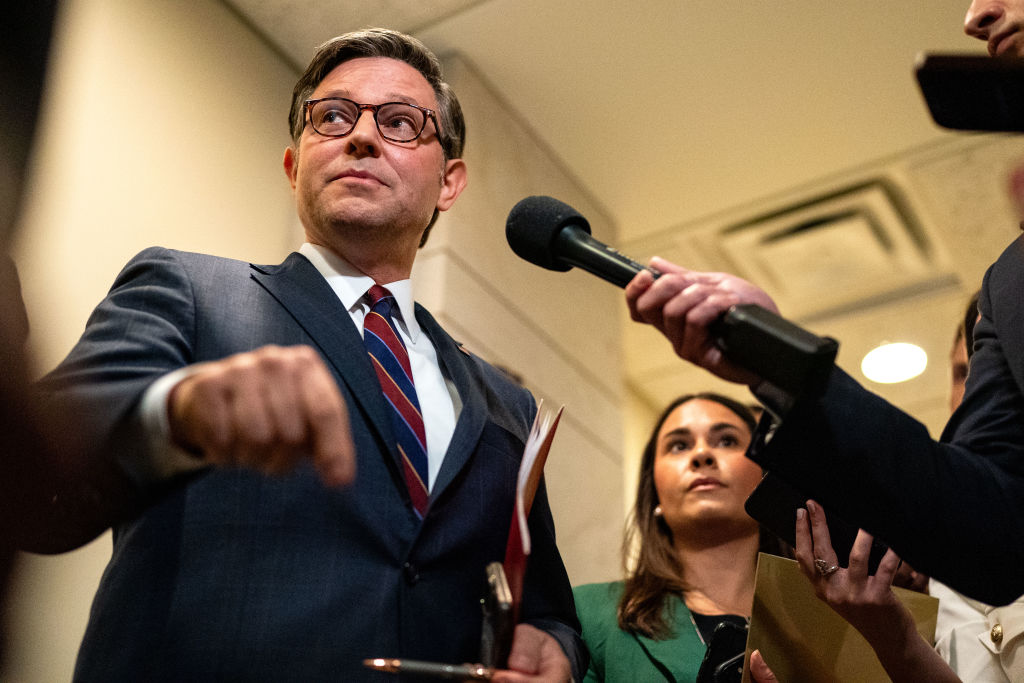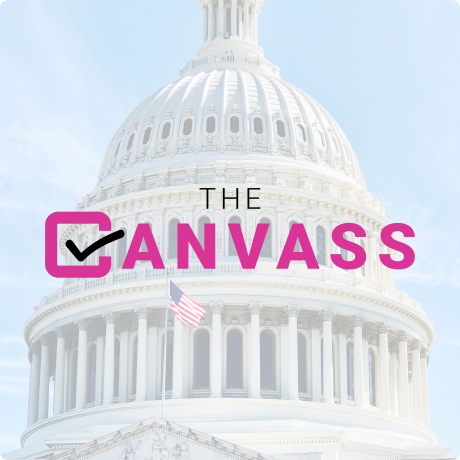PRESENTED BY

THE TOP
A primer: How to think about Johnson’s gov’t funding strategy

Happy Wednesday morning.
Speaker Mike Johnson and the House Republican leadership will host a call this morning for all GOP lawmakers to review his plan to fund federal agencies past the Sept. 30 deadline.
Johnson’s plan, as we’ve been detailing for the last few days, is to pass a six-month extension of government funding coupled with the SAVE Act. The SAVE Act requires proof of citizenship before registering to vote in a federal election.
It’s safe to say that this proposal is going absolutely nowhere fast in the Senate. Most savvy aides and lawmakers in the House Republican Conference understand that. Democratic leaders and the White House aren’t interested in the SAVE Act. Democrats we’ve spoken to in the House, Senate and White House also say that they want the stopgap to expire in December rather than March.
This is a pretty predictable move by Johnson. So we’re going to dissect the pros and cons for the speaker here.
The pluses. In case you needed a reminder, former President Donald Trump dominates the House Republican Conference and the larger GOP. Trump did so as president and after he left Washington. And now that he’s the GOP presidential nominee locked in a dead heat for the White House, his influence is seen again here.
Trump has been publicly and privately pressing for Johnson to include the SAVE Act as part of any short-term funding package. We’re not saying that Johnson wouldn’t have come to this conclusion on his own. But if you talk to the people who are truly in charge — meaning most of the House Republican leadership and GOP appropriators — they think this plan is futile.
So in taking this path, Johnson scores some points with Trump and his backers in Congress. And you know Trump is watching.
Furthermore, House Republicans traditionally have an insatiable appetite for their leaders picking fights, regardless of whether they have a chance of winning. Johnson will gain favor with GOP hardliners for having this fight with the Senate and White House, even though Democrats and many Republicans acknowledge that Johnson can’t win.
House Republicans’ stated goal this month is to choose battles that unite Republicans and divide Democrats. This does have the prospect of dividing Democrats — five Democrats voted for the SAFE Act in July.
The minuses. We think the minuses here outweigh any perceived benefits.
Let’s start with the simple fact that this maneuver will be tough for Republicans and isn’t certain to pass the House. We’ve already seen some Republicans say that this isn’t a winning tactic.
Since becoming speaker 315 days ago, Johnson has twisted himself into pretzels to avoid government shutdowns. Remember the “laddered CR?” So there’s no reason to believe that the speaker would risk a shutdown at the end of September, just five weeks before Election Day.
And imagine if this doesn’t pass the House? What if Johnson can’t bring this proposal to the floor? That would weaken his hand immeasurably in any spending negotiations going forward.
But how about when Johnson inevitably folds here? What will Republicans think of him then?
Also consider the implications of punting government funding until March. That means that Congress has no must-pass legislative vehicles in December to finish up its business beyond the annual defense authorization bill. There are a host of things that need to be done too, including raising the debt limit.
Parts of the farm bill expire on Sept. 30, while other sections expire at the end of the year. The federal government’s Counter-Unmanned Aircraft Systems authority runs out at the end of September. Medicaid and health care provisions that need to be renewed. Plus, Maryland is still seeking billions of dollars to rebuild the Francis Scott Key Bridge, and Free State lawmakers want the feds to pick up the full tab.
A six-month CR is also a very complicated bill to draft. There are spending “anomalies” that must be addressed across a host of federal agencies and departments. The Department of Veterans Affairs has warned of a $15 billion funding shortfall by the end of the fiscal year due to increased spending under the PACT Act. The White House wants billions of dollars for the WIC food program and Social Security Administration, among dozens of other requests. The Pentagon will have concerns.
Team Trump, which is pushing this CR play, also seems to be underestimating just how disruptive a March 31 deadline would be if Trump wins. March 31 is just 70 days into the new term. If Trump is elected, he’ll have to spend the majority of his first 100 days wrangling over funding. This is all but guaranteed to crimp a critical period in Trump’s return to power. Trump went through this in 2017 and it didn’t go well.
— Jake Sherman and John Bresnahan
Join us in downtown Austin tomorrow, Thursday, Sept. 5, starting at 9:30 a.m. CT for a full day of Punchbowl News programming at the Texas Tribune Festival. Don’t miss unforgettable conversations about the issues that matter to national politics. Tickets are available now.
– Anna Palmer will interview MSNBC’s Ali Velshi.
– Jake Sherman will sit down with Rep. Tony Gonzales (R-Texas).
– Andrew Desiderio will interview Arati Prabhakar, the White House’s director of the Office of Science and Technology Policy.
– We will host a live Brown Bag session.
– Melanie Zanona will sit down with House Democratic Caucus Chair Pete Aguilar.
PRESENTED BY CITI
How will digital currencies shape the future of finance?
As blockchain technology advances, digital currencies are poised to disrupt traditional banking models and could redefine the global monetary landscape. Central banks are working across global stakeholders to help determine what future adoption might look like – presenting both challenges and opportunities for businesses.
Explore in-depth analysis from Citi on the potential implications in the Citi GPS Report, Money, Tokens, and Games.
THE SENATE
Cornyn fundraises for Senate GOP and Trump
The months-long race to succeed Mitch McConnell as Senate GOP leader is kicking into high gear, with hopefuls capitalizing on the August recess to raise money for potential future colleagues whose votes they’ll need to win a leadership election.
We wanted to take stock of where the race stands when it comes to fundraising, a critical element of each candidate’s pitch to succeed McConnell, a master fundraiser. We’re starting today with Sen. John Cornyn (R-Texas), who’s undertaking a unique strategy.
According to a person familiar with Cornyn’s political operation, the former GOP whip raised money for Dave McCormick in Pennsylvania and will be in Ohio later this week to fundraise for Bernie Moreno. Both are challenging incumbent Democratic senators — Bob Casey in Pennsylvania and Sherrod Brown in Ohio respectively.
Cornyn has also been keeping in close touch with the candidates, often calling them directly to talk about their campaigns.
These efforts serve a dual purpose — helping boost the GOP’s majority-making candidates while also allowing Cornyn to campaign for the Republican Conference’s top job. That election is slated to occur shortly after the Nov. 5 elections.
The Trump wild-card: Interestingly, Cornyn also led a fundraising swing for former President Donald Trump throughout Texas in August alongside Trump’s running mate, Sen. JD Vance (R-Ohio). Cornyn was the special guest at Vance’s fundraisers in Laredo, San Antonio and Houston. The trip raised “well into the seven figures,” according to the person.
Getting involved in the presidential race is probably a smart move for Cornyn. While the election itself is conducted by secret ballot, Trump will undoubtedly have an influence on the outcome if he chooses to back a candidate.
This is also key for Cornyn because, over the last few years, he’s publicly questioned Trump’s ability to win in 2024. Circumstances have obviously changed, but Cornyn said as recently as last year that Trump doesn’t “understand” that “you have to appeal to voters beyond your base.”
Fundraising chops: Cornyn – a former two-term NRSC chair – has always been a strong fundraiser, and it’s a key part of his pitch in the leadership race. We reported in June that Cornyn, through his joint fundraising committee and direct-to-candidate efforts, had already bested his fundraising haul from the entire 2022 cycle.
At the end of the second quarter, Cornyn’s fundraising total for the 2024 cycle topped $23 million. That includes $3.5 million raised in the second quarter alone, which was his JFC’s best quarter in its history.
Of course, being from Texas gives Cornyn an advantage as well. Texas is an expensive state to fundraise in — not to mention the logistical difficulties given its size — so the candidates benefit more directly from the hard dollars raised through a JFC.
GOP money woes: This all comes as Republican campaign committees are sounding the alarm about what they say is a massive fundraising gap. The NRSC’s Jason Thielman told Politico that the “massive financial disparity our party currently faces” means they could “lose winnable seats.”
At the same time, the Harris-Walz campaign — which shattered fundraising records last month — is bankrolling Democratic candidates down the ballot.
More Senate campaign news: Rep. Jim Banks (R-Ind.), who’s likely to win a Senate seat in November, raised $100,000 for Moreno, the Ohio GOP Senate nominee, at a fundraiser in Ft. Wayne on Tuesday.
— Andrew Desiderio

Weekday mornings, The Daily Punch brings you inside Capitol Hill, the White House, and Washington.
Listen Now
The Vault: A big jobs week as markets shudder
It’s going to be another big week for the U.S. economy as investors and policymakers await two key bits of jobs data. Markets are already a little wobbly.
The first report, set to be published today at 10 a.m., is the Job Openings and Labor Turnover survey published by the Bureau of Labor Statistics.
The second, coming Friday morning at 8:30 a.m., is the bigger deal — the BLS’ monthly “employment situation” report, featuring the latest unemployment data.
These twin releases will give the Federal Reserve, along with Wall Street and the rest of the world, its best and final snapshot of the U.S. labor market before policymakers are expected to start cutting interest rates.
The federal funds rate has been stuck at 5.25% and 5.5% since July 2023, but Chair Jay Powell signaled it was time for cuts late last month. The Federal Open Market Committee meets starting Sept. 17.
Right now, the projections are optimistic. Economists surveyed by the Wall Street Journal expect job openings to hover around 8.1 million for the month of July, only a smidge lower the 8.2 million recorded in June — which was itself unchanged from May.
In the broader employment report, economists expect the jobless rate to tick down — from 4.3% to 4.2% — after adding about 161,000 jobs in August.
The stakes: With the timing of rate cuts seemingly set, the question for traders and lawmakers alike will be the size of those cuts.
A shakier labor market will raise concerns about a looming recession, which could prompt the Fed to cut faster and jumpstart some economic growth. Remember, though, that monetary policy moves take time to seep into the economy.
The baseline for Fed cuts in recent years has been around 25 basis points. A large cut would come in around 50 basis points, while a “jumbo” cut could be as high as 75 basis points — which is what lawmakers like Sen. Elizabeth Warren (D-Mass.) are calling for.
Enjoying our coverage? Don’t miss daily breaking financial services and tax news, expert analysis, weekly newsletters, reporter briefings and much more. Become a Premium Policy member today!
— Brendan Pedersen
PRESENTED BY CITI

As blockchain technology advances, digital currencies may reshape the future of finance. Explore the potential impact in the Citi GPS Report, Money, Tokens, and Games.

Abortion rights dominate House Democratic ads
Exclusive: We have three new Democratic ads for you this morning, running in competitive House districts in different parts of the country. In a sign of where Democratic messaging is heading, all three ads — from New York, California and Nevada — share the common theme of abortion rights.
— In New York’s 19th District, the DCCC Independent Expenditure arm is running an attack ad that chips away at Rep. Marc Molinaro’s (R-N.Y.) attempt to strike a moderate tone on reproductive rights.
The ad says Molinaro voted to restrict abortion rights 13 times in his first term in office. The spot singles out his vote in favor of the Pregnant Students’ Rights Act in January, which Democrats claim would limit access to abortion for college students.
— California Democrat Dave Min is slamming his Republican opponent Scott Baugh as an extremist who supports an abortion ban with no exceptions for rape or incest. Min is running to succeed Rep. Katie Porter (D-Calif.) in the state’s competitive 47th District.
“The MAGA power grab stops here,” Min says in the ad.
— Frontline Democratic Rep. Dina Titus’ (Nev.) new ad starts off with the incumbent closing a door to a medical exam room with a woman and her doctor.
“Some politicians want to sit in the exam room with you and make decisions for you,” Titus says in the ad. “Not only is that wrong, it’s dangerous.”
The ad accuses Titus’ GOP opponent in the competitive 1st District, Mark Robertson, of supporting a “near-total” abortion ban.
Democrats leaning almost singularly on abortion was something we focused on in our Midday edition on Tuesday when we broke down House Majority PAC’s latest ad buys.
Massachusetts primary: Voters in Massachusetts headed to the primary polls on Tuesday. There weren’t any major shocks.
Republican John Deaton will face Sen. Elizabeth Warren (D-Mass.) in the general election. As we reported last month, Warren has $4 million more on hand than Deaton and is the massive favorite.
Every single House Democratic incumbent won their primary without facing a challenger.
— Max Cohen
THE CAMPAIGN
Stefanik hosting women’s fundraiser for Trump
New: House Republican Conference Chair Elise Stefanik is appearing at a gigantic D.C. fundraiser for former President Donald Trump.
The Sept. 12 fundraiser is a “women’s leadership coalition” event for Trump. Emily Lampkin, the chair of Trump’s Women’s Coalition, is the top host of the fundraiser. Jessica Mandel, a principal at Miller Strategies, one of the top Trump-linked lobbying shops, is also a host.
There are a host of GOP lawmakers listed as special guests, including Sens. Marsha Blackburn (Tenn.), Katie Britt (Ala.) and Shelley Moore Capito (W.Va.).
It will cost you $500 to get in the door. Co-hosts have to give $1,000 and hosts have to give or raise $10,000.
— Jake Sherman
MOMENTS
ALL TIMES EASTERN
11:45 a.m.
President Joe Biden will get his daily intelligence briefing.
12:15 p.m.
Vice President Kamala Harris will travel to Portsmouth, N.H., arriving at 1:35 p.m.
1:30 p.m.
Press Secretary Karine Jean-Pierre will brief.
2:50 p.m.
Harris will deliver remarks at a campaign event in Portsmouth.
5:10 p.m.
Harris will depart Portsmouth en route to D.C., arriving at 6:35 p.m.
CLIPS
NYT
“Tim Sheehy Was Recorded Using Racist Stereotypes About Native Americans”
– Kellen Browning
NYT
“Harris, Proposing a Tax Break, Makes a Play for Small-Business Owners”
– Andrew Duehren and Nicholas Nehamas
WaPo
“Ukraine’s foreign minister resigns amid government shake-up”
– Siobhán O’Grady in Kyiv, Ukraine
WSJ
“Trump Wants to ‘Drill, Baby, Drill,’ but Can He Cut Energy Prices?”
– David Uberti and Jennifer Hiller
CNN
“CNN polls across six battlegrounds find Georgia and Pennsylvania are key toss-ups”
– Jennifer Agiesta, Ariel Edwards-Levy and Edward Wu
PRESENTED BY CITI
How will digital currencies shape the future of finance?
As blockchain technology advances, digital currencies are poised to disrupt traditional banking models and could redefine the global monetary landscape – presenting both challenges and opportunities for businesses.
| → | Blockchain-based products can make a significant impact in terms of wide consumer adoption in digital currency, especially central bank digital currency (CBDCs), gaming, and social. |
| → | Momentum on adoption has positively shifted as governments, large institutions, and corporations have moved from investigating the benefits of tokenization to trials and proofs of concept. |
Explore in-depth analysis from Citi on the potential implications in the Citi GPS Report, Money, Tokens, and Games.
Editorial photos provided by Getty Images. Political ads courtesy of AdImpact.
Presented by Apollo Global Management

America’s economic growth requires bold investment. Apollo is investing in American companies to help them hire, grow and build for the road ahead. Learn more.

Crucial Capitol Hill news AM, Midday, and PM—5 times a week
Join a community of some of the most powerful people in Washington and beyond. Exclusive newsmaker events, parties, in-person and virtual briefings and more.
Subscribe to Premium
The Canvass Year-End Report
And what senior aides and downtown figures believe will happen in 2023.
Check it outEvery single issue of Punchbowl News published, all in one place
Visit the archive
Presented by Apollo Global Management

America’s economic growth requires bold investment. Apollo is investing in American companies to help them hire, grow and build for the road ahead. Learn more.







